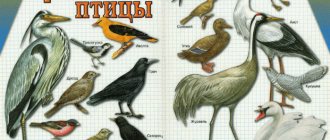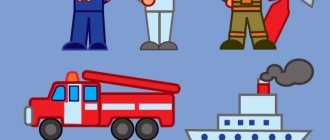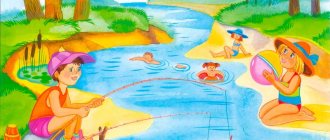Progress of the lesson
Introductory part
The teacher greets the children and they take their seats. At this time, cheerful music plays, and a toy airplane appears in front of the teacher. The music stops playing. The teacher says:
“Children, it seems that someone is coming to visit us. Let's try to guess his name. Listen to the riddle:
I am a bird, although I don’t fly, but I sunbathe on an ice floe. I catch and eat fish myself, I’m not afraid of the cold at all.
Children guess the name of the bird, the adult continues: “You guessed correctly that this riddle is about a penguin, but how can we guess his name? Need a hint."
At this time, a small backpack is lowered from the airplane onto the table. From it the teacher takes out an adjustable wrench, a hammer, and a screwdriver. Children are asked to name everything in one word and remember other instruments.
Game "Who is bigger?"
The ball is passed around the circle and everyone who picks it up names an instrument.
Federal State Educational Standards standards recommend introducing children in the preparatory group to the tools that they can observe at work.
Educator: “Guys, you named so many instruments, well done!” Tell me, who needs them every day? Who is the one who is constantly fixing something and coming up with new mechanisms? What are people of this profession called? Children answer (engineer, mechanic, inventor).
Educator: “Now have you guessed which bird flew to us today? A cheerful inventor who looks like a ball. This is a Smesharik penguin, and his name is Pin.” Pin greets the children and asks them to name today's day of the week and remember the name of the activity that is held on that day.
Articulation gymnastics
The children answer, and the teacher reminds them that during Speech Development they learn to speak beautifully and correctly; special speech exercises and articulatory gymnastics help a lot with this.
Teacher: “Guys! You already know very well many different exercises for the tongue. Today I suggest you make your usual gymnastics even more interesting for him. Now I will lay out the cards on the table. Each of you can take one of them, look at the picture, but not show it to others. A drawn object or action can be depicted using a tongue, we have already done this. Everyone must remember the exercise and then show it to others. Everyone repeats after the leader. If someone guessed that we are showing everything, then he can raise his hand. If the answer is correct, then he and the presenter each receive a reward token.”
Children take turns coming to the table, turning over one picture at a time from standard sets for classes on speech development in kindergarten and performing one of the elements of articulatory gymnastics (“needle”, “spatula”, “jam”, “cup”).
The teacher praises the children, prize tokens are placed in a lapbook on speech development, collected by the children on this topic.
Game “Professions”
Each child (or two or three, in a subgroup) receives an image of a worker in a certain specialty, everyone takes turns calling them. An adult takes one object picture from the pile and names it. Children must choose the right ones for a particular profession. The teacher asks the children “Why does a doctor need a syringe? Painter's brush? Seamstress threads?
A moment of poetry
The teacher reads to the children a poem by J. Rodari “What crafts smell like.” The teacher discusses with the children professions that “smell delicious” and asks for examples. Children name the cook, pastry chef, and sweets seller.
Compiling a story based on plot pictures
The teacher asks: “What do we call the one who makes sweets? (confectioner). Let's look at the pictures and tell you about the people who make this delicacy. There are many different workers working at the factory.”
The teacher calls the children one by one and asks them to tell what they like most in the pictures. What would every child want to be in a factory, why? Then the pictures are hung in order.
Say the word (joint composing of a story)
The teacher offers to tell Pin about how the delicious cold delicacy is made, which he also loves very much. The teacher begins the story, the children add:
“Today we found ourselves at (an ice cream factory). This is a large back room, inside of which there are special machines that make ice cream. There are also huge refrigerators that are needed (for storing finished goods). Ice cream comes in different types, we know (ice cream, popsicle, chocolate, berry). All these varieties are made from (milk and sugar). They are brought to the factory in large trucks (by drivers). Cars help unload (loaders). The preparation of ice cream is closely monitored (technologists). The finished briquettes and cups need to be carefully wrapped; for this, packers work at the factory. We can buy fresh delicious ice cream in (shop, cafe, kiosk).”
Phys minute
The finished ice cream travels around the city and around the country, let's travel a little too.
The teacher reads I. Tokmakova’s poem “Let’s Play” and shows the movements corresponding to various types of transport.
We rode on a horse and reached the corner. (galloping, “reins” in hands) We got into the car, poured gasoline. (turn the steering wheel, honk) We were driving a car and reached the river. (we depict waves with our palms) Trrr! Stop! U-turn. There is a steamer on the river. (turn 360 degrees) We traveled by steamboat and reached the mountain. (we describe circles with our hands, then fold them over our heads) The steamer is not lucky, We need to get on the plane (arms parallel to the floor) The plane is flying, the engine is humming in it: (we move in a circle, arms are wings) Oooh!
All classes in the preparatory group must certainly include a dynamic pause, but it may be located a little further from the beginning of the lesson than in the older group.
Game “Say it backwards!”
The teacher takes out a toy ice cream, treats Ping and invites the children to play. She says: “I will say the word, and you must say it backwards. This is a game of flip-flops or “black and white”. For example: Ice cream is cold, but you say (hot), white - black, large - small."
If everyone understands the rules, then the teacher reads out a list of words: (bright, new, clean, smooth, cheap, warm, brave, cheerful, young, long). Complete lists of other words with antonyms can be found in the GCD notes in the preparatory group, corresponding to a particular topic.
Game "Graphic dictation"
The teacher says: “And now we will play another interesting game - graphic dictation. You need to be very careful to repeat my instructions exactly.” Children perform a dictation, which produces an image of an airplane.
Methodical techniques
During the lesson the following methodological techniques are used:
- use of game moments;
- use of visual materials, handouts and plot images;
- consistent development of skills in composing a story using unfinished sentences;
- objective encouragement of active independent work of children (tokens).
These techniques are no less important in the preparatory group of a kindergarten than when working with younger children.



